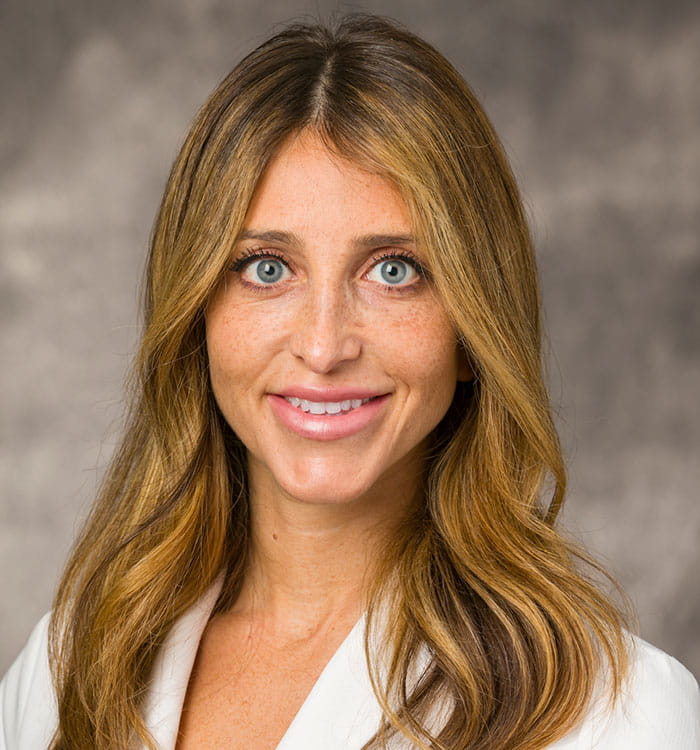New Hope for Patients with Treatment-resistant Bipolar Disorder
December 31, 2017
Study uses advanced imaging to identify targets for deep brain stimulation in severe cases of the disease
 Jennifer Sweet, MD
Jennifer Sweet, MDUH Neurological Institute - Winter 2018
Deep brain stimulation (DBS) has long been used to treat movement disorders – such as Parkinson’s disease, essential tremor and dystonia – as well as obsessive-compulsive disorder and severe Tourette’s syndrome. While more doctors have begun using DBS to treat depression, to our knowledge, none have examined its use in treating bipolar patients cycling between mania and depression, says Jennifer Sweet, MD, Neurosurgeon, Division of Functional & Stereotactic Neurosurgery, UH Cleveland Medical Center; Assistant Professor of Neurosurgery, Case Western Reserve University School of Medicine.
Dr. Sweet leads a team at University Hospitals in Cleveland, Ohio, that is studying the possible use of DBS to improve the lives of patients with severe treatment-resistant bipolar disorder. Funded by a National Institutes of Health grant, the study is using a special kind of brain imaging known as tractography to learn whether the neural pathways of patients with bipolar disorder are fundamentally different from others.
“Magnetic resonance imaging in these patients looks normal, but we suspect they have abnormal ‘wiring’ that underlies their disorder,” she says.
She and her colleagues have been using tractography to compare the brains of bipolar sufferers with a healthy control group and ultimately identify an area of abnormality that could be targeted with DBS. MRI images are put through computational models that manipulate findings and help doctors visualize pathways.
“We can see some of the white matter pathways in the brain with existing technology, but it’s very hard to see the more complex and specific circuitry,” Dr. Sweet explains. “We know that there are numerous interconnected networks regulating mood and thought in the brain, and we are trying to figure out exactly how those networks play a role in various disorders so that we can use neuromodulation to modify aberrant activity.”
NEW HOPE FOR PATIENTS
The overall goal of the UH DBS study is to help bipolar patients who are resistant to medication and other therapies to stop the cycling between mania and depression.
“For many patients, the cycling between mood states makes bipolar disorder a chronic and recurrent illness,” Dr. Sweet says. “If we can stop the cycling, it may be curative, rather than the current approach of treating the symptoms of mania and/or depression. We do not know of any other centers in the country that are focusing on this approach to bipolar disorder.”
The study has already exceeded enrollment goals for the initial imaging phase, which examined healthy volunteers, treatment-resistant bipolar patients and treatment-responder bipolar patients. Data analysis is expected to continue for the next several months, and Dr. Sweet hopes to start recruiting patients for the treatment portion in late 2018.
She says only a small group of patients who are found to have abnormal imaging – and who have failed at least four types of FDA-approved treatments, including electroconvulsive therapy and medications – will be treated first to demonstrate the efficacy of the approach.
“We have been doing DBS for decades so we know it’s a safe therapy, but our question is if it will be effective in a new location in the brain for the treatment of a new disease – bipolar disorder,” Dr. Sweet says.
Bipolar disorder is a particularly burdensome condition in that it disproportionately affects younger people. About half of all sufferers are diagnosed by 14 years of age, with up to three-quarters diagnosed by age 24.
“This is a highly functioning group of people and yet they can become so debilitated by the disease that they can no longer work or have healthy relationships,” Dr. Sweet says. “We hope to help them overcome these obstacles.”
A COLLABORATIVE EFFORT
She says she is deeply appreciative of the world-renowned experts available to collaborate with her, including:
- Keming Gao, MD, PhD, psychiatrist and Clinical Director, Mood Disorder, and Medical Director, Electroconvulsive Therapy, UH Cleveland Medical Center; Professor of Psychiatry, Case Western Reserve University School of Medicine
- Jonathan Miller, MD, neurosurgeon and Director, Functional and Restorative Neurosurgery Center and Vice Chairman, Educational Affairs, UH Cleveland Medical Center; Associate Professor, Neurosurgery, the School of Medicine
- Joseph Calabrese, MD, psychiatrist and Director, Mood Disorders Program, UH Cleveland Medical Center; Professor of Psychiatry, the School of Medicine
- Cameron McIntyre, PhD, Professor, Department of Biomedical Engineering, the School of Medicine.
We ensure continuity of care from referring physician to specialist by providing prompt communication after each patient visit and carefully coordinated perioperative management. To refer a patient, call 216-844-2724.


